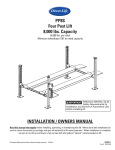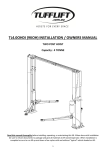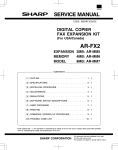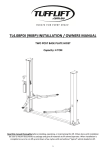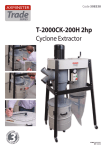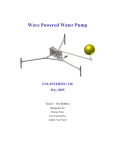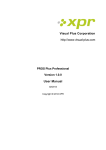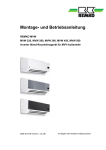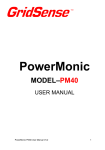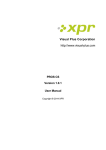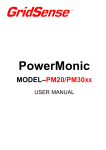Download TL3.6PH-S (PP8S) INSTALLATION / OWNERS MANUAL
Transcript
TL3.6PH-S (PP8S) INSTALLATION / OWNERS MANUAL FOUR POST HOIST Capacity: 3.6 TONNE Read this manual thoroughly before installing, operating, or maintaining this lift. When done with installation be sure to return documents to package and give all materials to lift owner/operator. When installation is complete be sure to run lift up and down a few cycles with and without “typical” vehicle loaded on lift. 1 TABLE OF CONTENTS IMPORTANT INFORMATION pg 2 LIFT SPECIFICATIONS & FLOOR PLAN pg 3 TOOLS REQUIRED pg 4 INSTALLATION INSTRUCTIONS pg 4 CASTER KIT ASSEMBLY / INSTALLATION pg 7 FOUNDATION & ANCHORING REQUIREMENTS pg 9 LOCKOUT / TAGOUT pg 10 SAFETY PROCEDURES pg 11 OPERATION INSTRUCTIONS pg 12 PREVENTIVE MAINTENANCE SCHEDULE pg 13 TROUBLESHOOTING pg 15 CABLE INSPECTION GUIDE pg 16 ILLUSTRATED PARTS LIST pg 20 WARRANTY pg 29 IMPORTANT INFORMATION Four Post Lifts 1. 2. 3. 4. 5. 6. 7. 8. Always inspect the lift for damage and make note of any damage on the bill of lading. In case of freight damage, call the truck line immediately and report the damage as a freight claim. Make sure you have extra help or heavy duty lifting equipment when unloading and assembling the lift. Please read the safety procedures and operating instructions in this manual before operating lift. Keep this manual near lift at all times. Make sure all operators read this manual. NOTE: Are you installing in a level location? (Lift must be anchored in place if slope is greater than 1/8" per foot.) Make sure you have enough room to install the lock rods. You will need at least 9’(2743mm) of clearance from the opposite end of the power unit end of the lift and 6’(1829mm)at the power unit end. (See floor plan on page 6). The power unit may be installed on the driver’s front or the passenger rear corner. Never raise a car until you have double checked all bolts, nuts and hose fittings. Always lower the lift to locks before going under the vehicle or storing another vehicle underneath lift. Never allow anyone to go under the lift when raising or lowering. This is a vehicle lift installation/operation manual and no attempt is made or implied herein to instruct the user in lifting methods particular to an individual application. Rather, the contents of this manual are intended as a basis for operation and maintenance of the unit as it stands alone or as it is intended and anticipated to be used in conjunction with other equipment. Proper application of the equipment described herein is limited to the parameters detailed in the specifications and the uses set forth in the descriptive passages. Any other proposed application of this equipment should be documented and submitted in writing to the factory for examination. The user assumes full responsibility for any equipment damage, personal injury, or alteration of the equipment described in this manual or any subsequent damages. Read this manual thoroughly before installing, operating, or maintaining this lift. When done with installation, be sure to return documents to package and give all materials to lift owner/operator. When installation is complete be sure to run lift up and down a few cycles with and without “typical” vehicle loaded on lift. 2 LIFT SPECIFICATIONS & FLOOR PLAN 3 TOOLS REQUIRED FOR INSTALL The installation of this lift is relatively simple and can be accomplished by two men in a few hours. The following tools and equipment are needed: • Set of metric wrenches and/or sockets • Locking pliers • Adjustable wrench • 25’(7.62m) Tape measure • ISO 32 Light Hydraulic Oil (approx. 3 gallons) • Step Ladder INSTALLATION PROCEDURE STEP 1. Remove plastic wrap from top runway and remove all hardware, safety lock rods, hoses and cables. You should also find this manual in the top runway. STEP 2. Find the end of the hose that is already mounted to the cylinder and tighten the elbow that attaches the hose to the side of the runway using the jam nut. Also, check the fitting at the cylinder end and make sure it is tight. STEP 3. Extend cylinder rod out of the cylinder to about 18”(457mm) from end of runway. This can be done by pulling or pushing on the ½”(12.7mm) plate on the end of the cylinder. Make sure that the ½”(12.7mm) plate is threaded tight against the cylinder rod. Also, be sure the ¼”(6.35mm) plate is on the rod and hand tighten the lock nut on the end of the cylinder. STEP 4. Unbolt the top runway from the shipping plates at each end of the package. Be sure to secure runway with hoist to prevent runway from falling. Runway will need to be turned over so it is no longer upside down. Place this runway in your bay with the hydraulic fitting facing towards the outside (see Page 1). STEP 5. Next, unbolt the four columns from the package and place the column with the power unit mounting bracket at the end of the previously unpacked runway nearest to the hydraulic fitting. Stand these columns on their base plates with the locking ladders facing to the outside (front to rear) and pulleys toward the inside (see Fig. 1). STEP 6. Unpack the bottom runway. Lay the approach ramps near the approach end of the lift and set out the remaining parts away from the lift. Place the two cross rails at each end of the lift with the locks toward the outside (front or rear) of the lift (see Fig. 1). Remove the shipping brackets from the bottom runway and turn over placing the runway in the bay next to the other runway with the “L” shaped side facing the “L” shaped side of the other runway. STEP 7. If you have a means for securely lifting cross rails high enough to lower them into the top of the columns, then remove the top plates from the top of the columns while the columns are standing. If you don’t have a means for securely lifting them, then you will need to lay the columns down and remove the top plates to allow the cross rails to be slid into the columns. STEP 8. Slide each cross rail into the front or rear two columns by holding the lock lever down, to allow the rail to slide past the locking positions. Leave the cross rail locked in the lowest position on the column. Repeat this step for the other cross rails (see Fig. 1). STEP 9. Position the front cross rail columns at 170”(4318mm) from the rear cross rail columns by measuring from the outsides of the columns. Square the lift by measuring diagonally between the right, front column to the same position on the lift rear column. Compare your measurement between the left front column and the right rear column. This should be within ½”(12.7mm) to allow some forgiveness to bolt on runways. STEP 10. Lift the runways onto the cross rails and bolt them in place using the ¾”(19mm) holes towards the outside of the cross rails. The four drop-in ramp plates will be used with the spacer side facing the lift and through-bolted from the outside of the cross rail, through the runway using bolts provided with washers. Lock washers and nuts (see Fig. 2). STEP 11. After runways are bolted on, install the column top plates back to their original columns and tighten. 4 CABLE INSTALLATION STEP 12. Lay out all cables and measure from end to end to determine correct cable positions (see Fig. 3). STEP 13. Since the nub end of the cable is easier to feed through the pulley, start with the pulley at the end of the cross bar and work your way back to the cylinder (see Fig. 3). STEP 14. Install cable numbs into appropriate slots in ½”(12.7mm) plate and secure with slots on ¼”(6.35mm) plate. Tighten the nubs so the nylock nut is fully threaded onto the head of the cylinder. This cable bracket should still be able to move freely on the cylinder head. STEP 15. Run the threaded cable ends into the hole in the top caps and secure with washer and nylock nut. Hand tighten only, final adjustment will be made later. Do tighten the nylock nut on the end of the cylinder at this time. HYDRAULIC ASSEMBLY STEP 16. Be sure wiring is in compliance with your local electrical codes. STEP 17. Rind the four 5/16”(7.94mm) bolts, nuts and lock washers and attach the power unit to the mounting bracket on the column. STEP 18. Remove dust cover from the port on the side of the power unit and attach the “O” ring elbow. Do not over tighten. The backing nut and “O” ring will complete the seal to the power unit. STEP 19. Install the 3/8”(9.5mm) hose to the fitting on the side of the runway and connect opposite end to the fitting on the power unit. Tighten JIC fittings carefully, do not over tighten. LOCK LINKAGE ASSEMBLY STEP 20. The single point safety lock is a system of connecting rods and linkage that disengage the four lock latches that secure the lift to each column. Locate the six rods: a. 2 – long rods b. 2 – short rods c. 1 – handle rod d. 1 – T rod Also locate hardware: a. 1 – rod coupling with 2 jam nuts b. 8 – heim ends with connecting nuts and bolts c. 2 – spacers STEP 21. Slip spacer over threaded end of handle rod and insert rod into hole on cross bar near power column. STEP 22. Slip spacer over threaded end of T-rid and insert end into hole located on opposite cross rail, taking care to run rod through rod guide located under ramp. STEP 23. Thread jam nuts onto ends of handle rod and T-rod. Attach the handle rod to the T-rod using the rod coupling. Adjust coupling to take the slack out of the rods. The rods should remain free enough to move with no slack. Do night tighten coupler or lock nuts at this time. STEP 24. Locate the two long rods and remove on end from each rod and slide off the eye bolt. Attach eye bolts to center of cross rails by threading ½ of the way in and tighten jam nut. STEP 25. Attach short rod on the T side lock and to the bottom of the T and hand tighten. Slide long rod through the eye bolt and attach one end to the top side of T. Attach the other end of the long rod to the lock on the other side. Repeat this process for the other end of the lift. The locking rods should be in perfect alignment since the lift is still sitting in the locked position. Tighten all jam nuts, making sure the linage does not bind. STEP 26. Go back to the coupler that attaches the T rod to the handle rod and tighten the jam nuts. Do no adjust coupler, only tighten the jam nuts. 5 FINAL ADJUSTMENTS STEP 27. Fill the tank with three gallons of R & O, ISO32 Hydraulic Oil (Available at any auto supply store). STEP 28. Check over cables and make sure they are all in their pulleys. Press the up switch on the power unit and the fluid will start to pump into the cylinder. The lift will eventually rise after the cylinder fills up. Once the lift is raised of the locks, release the up switch and pull the lock lever to disengage the locks and lower the lift with the lowering lever on the power unit. Hold the lever after the lift reaches the very bottom until you hear all the air escape. STEP 29. Raise the lift up to the point where the square blocks above the lock aligns with the second column lock, and stop. Look at each column lock to determine the highest point. Adjust the cable on the highest point column until three threads pass through the nylock nut. Now adjust the other three cables to match this height. NOTE: There will some initial stretching of the cables in the beginning. It will be necessary to readjust the cables a week after first use, then every six months thereafter. Run the lift up and down a few times to insure that the locks are engaging uniformly and that the safety release mechanisms are functioning properly. Read just if necessary. STEP 30. After the cables are installed and adjusted, unbolt the sheave covers (Item # 69), Figure # 2. Slide the sheave covers up the cable until you can access the cable sheave. Install the 8mm cable retention bolts into the threaded holes by the sheaves at the end of the crossbeams (Item # 101and 102) Figure # 2. Assure they extend across the width of the sheaves and the bolt heads do not interfere with the sheaves. Install the 8mm lock nuts to the end of the bolts to lock them into position. Re-install sheave covers. 6 OPTIONAL CASTER KIT 1. Install caster wheels to caster frames as shown. NOTE: Hitch Pin and Hairpin Clip will be used to attach casters to lift in following steps. DO NOT install at this time. 7 1. Raise lift 2’ – 3’ (906mm – 914mm) high. 2. Place caster assemblies under crossbeams as shown. Secure with Hitchpin and Hairpin Clip. 3. Lower lift and the columns will automatically raise off the floor. 8 FOUNDATION REQUIREMENTS Concrete shall have compression strength of at least 3,000 PSI and a minimum thickness of 4” (102mm). CAUTION!! DO NOT use on asphalt or similar unstable surfaces. SPECIAL NOTE: This Lift does not require bolting to the floor (BUT) If you choose the option to anchor the Lift to the floor please follow the detailed instructions and criteria below. FOUNDATION and ANCHORING REQUIREMENTS 1. Concrete shall have compression strength of at least 3,000 PSI and a minimum thickness of 4” (102mm) in order to achieve a minimum anchor embedment of 3 ¼” (83mm). NOTE: When using (¾” x 5 ½”)(19 x 140mm) long anchors; if the top of the anchor exceeds 2 ¼” (57mm) above the floor grade, you DO NOT have enough embedment. 2. Maintain a 6” (152mm) minimum distance from any slab edge or seam. Hole to hole spacing should be a minimum 6 ½” (165mm) in any direction. Hole depth should be a minimum of 4” (102mm). 3. Shim each column base as required until each column is plumb. If one column has to be elevated to match the plane of the other column, full size base shim plates should be used. Torque anchors to 85 ft-lbs (115.2nm). Shim thickness MUST NOT exceed ½” (12.7mm) when using the 5 ½” (140mm) long anchors with the lift. Adjust the column extensions plumb. 4. If anchors do not tighten to 85 ft-lbs (115.2nm). installation torque, replace the concrete under each column base with a 4’ x 4’ x 6” (1219 x 1219 x 152mm) thick 3,000 PSI minimum concrete pad keyed under and flush with the top of existing floor. Allow concrete to cure before installing lifts and anchors (typically 2 to 3 weeks). CAUTION!! LUBRICATE ALL CABLE SHEAVES, BEARINGS, AND SHAFTS WITH GREASE PRIOR TO OPERATING THE LIFT. LUBRICATE ALL ON AN ANNUAL BASIS. Motors and all electrical components are not sealed against the weather and moisture. Install this lift in a protected indoor location. Failure by the owner to provide the recommended shelter could result in unsatisfactory lift performance, property damage, or personal injury. 9 LIFT LOCKOUT/TAGOUT PROCEDURE Purpose This procedure establishes the minimum requirements for the lockout of energy that could cause injury to personnel by the operation of lifts in need of repair or being serviced. All employees shall comply with this procedure. Responsibility The responsibility for assuring that this procedure is followed is binding upon all employees and service personnel from outside service companies (i.e., Authorized Installers, contactors, etc.). All employees shall be instructed in the safety significance of the lockout procedure by the facility owner/manager. Each new or transferred employee along with visiting outside service personnel shall be instructed by the owner/manager (or assigned designee) in the purpose and use of the lockout procedure. Preparation Employees authorized to perform lockout shall ensure that the appropriate energy isolating device (i.e., circuit breaker, fuse, disconnect, etc.) is identified for the lift being locked out. Other such devices for other equipment may be located in close proximity of the appropriate energy isolating device. If the identity of the device is in question, see the shop supervisor for resolution. Assure that proper authorization is received prior to performing the lockout procedure. Sequence of Lockout Procedure 1. Notify all affected employees that a lockout is being performed and the reason for it. 2. Unload the subject lift. Shut it down and assure the disconnect switch is “OFF” if one is provided on the lift. 3. The authorized lockout person operates the main energy isolation device removing power to the subject lift. a. If this is a lockable device, the authorized lockout person places the assigned padlock on the device to prevent its unintentional reactivation. An appropriate tag is applied stating the person’s name, at least 3” x 6” (152 x 76mm) in size, an easily noticeably color, and states not to operate device or remove tag. b. If this device is a non-lockable circuit breaker or fuse, replace with a “dummy” device and tag it appropriately as mentioned above. 4. Attempt to operate lift to assure the lockout is working. Be sure to return any switches to the “OFF” position. 5. The equipment is now locked out and ready for the required maintenance or service. Restoring Equipment to Service 1) Assure the work on the lift is complete and the area is clear of tools, vehicles, and personnel. 2) At this point, the authorized person can remove the lock (or dummy circuit breaker or fuse) and tag and activate the energy isolating device so that the lift may again be placed into operation. Rules for Using Lockout Procedure Use the Lockout Procedure whenever the lift is being repaired or serviced, waiting for repair when current operation could cause possible injury to personnel, or for any other situation when unintentional operation could injure personnel. No attempt shall be made to operate the lift when the energy isolating device is locked out. Operating Conditions Lift is not intended for outdoor use and has an operating ambient temperature range of 41º-104ºF (5º-40ºC). 10 IMPORTANT SAFETY INSTRUCTIONS When using your garage equipment, basic safety precautions should always be followed, including the following: 1. Read all instructions 2. Care must be taken as burns can occur from touching hot parts. 3. Do not operate equipment with a damaged cord or if the equipment has been dropped or damaged - until it has been examined by a qualified service person. 4. Do not let a cord hang over the edge of the table, bench, or counter or come in contact with hot manifolds or moving fan blades. 5. If an extension cord is necessary, a cord with a current rating equal to or more than that of the equipment should be used. Cords rated for less current than the equipment may overheat. 6. Always unplug equipment from electrical outlet when not in use. Never use the cord to pull the plug from the outlet. Grasp plug and pull to disconnect. 7. Let equipment cool completely before putting away. Loop cord loosely around equipment when storing. 8. To reduce the risk of fire, do not operate equipment in the vicinity of open containers of flammable liquids (gasoline). 9. Adequate ventilation should be provided when working on operating internal combustion engines. 10. Keep hair, loose clothing, fingers, and all parts of body away from moving parts. 11. To reduce the risk of electric shock, do not use on wet surfaces or expose to rain. 12. Use only as described in this manual. Use only manufacturer's recommended attachments. 13. ALWAYS WEAR SAFETY GLASSES. Everyday eyeglasses only have impact resistant lenses, they are not safety glasses. SAVE THESE INSTRUCTIONS SAFETY PROCEDURES Never allow unauthorized persons to operate lift. Thoroughly train new employees in the use and care of lift. Caution - the power unit operates at high pressure. Remove passengers before raising vehicle. Prohibit unauthorized persons from being in shop area while lift is in use. Total lift capacity is 8,000-lbs (3.6T). Do not exceed this capacity. Prior to lifting vehicle, walk around the lift and check for any objects that might interfere with the operation of lift and safety latches; tools, air hoses, shop equipment. When approaching the lift with a vehicle, make sure to center the vehicle between the columns. Slowly drive the vehicle up with someone outside the vehicle guiding the driver. Prior to lowering vehicle, walk around the lift and check for any objects that might interfere with the operation of lift and safety latches; tools, air hoses, shop equipment. Slowly drive the vehicle on and off of the lift. Have someone outside the vehicle guide the driver. 11 OPERATION INSTRUCTIONS NOTE: ALWAYS CHOCK WHEELS AND SET PARKING BRAKE BEFORE LIFTING VEHICLE! Only authorized personnel are to operate lift. Properly maintain and inspect lift in accordance to owner' manual. Do not operate a lift that is damaged or in need of repair. Allow only authorized personnel in the lift bay. Stay clear of lift when raising or lowering (no riders). Keep hands and feet away from pinch points at all times. Never override the lift operating and safety controls. If a vehicle is suspected of falling, clear area immediately. Do not rock vehicle while positioned on lift. Always use safety jack stands when removing or installing heavy components. Vehicle Loading: Position vehicle on lift runways by having another person guide you onto the runways. Check for proper weight distribution (center of gravity should be evenly distributed between columns). Set vehicle parking brake and chock tires to prevent vehicle movement. Use caution before lifting pickup trucks, suv's and other vehicles. The individual axle weight capacity should not exceed 1/2 of lift capacity. Make sure vehicle is neither front nor rear heavy. Raising Lift: Push up switch to raise lift until platform runways clear floor. Stop and check for vehicle movement and vehicle weight distribution. If secure raise to desired height. Always lower the lift to the nearest lock position by pressing the lower lever to relieve the hydraulic pressure and let the latch set tight in a lock position. Never work under a lift that is not in the locked position. Lowering Lift: Clear all obstacles from under lift and vehicle, and ensure only lift operator is in the lift area. Stay clear of lift and raise the lift off the safety locks. Pull safety latch releases and press the lower lever to begin descent. Ensure lift is fully lowered, and having another person guide you, carefully unload the lift by driving off of the lift runways. CAUTION PAY ATTENTION TO THE LOWERING SPEED OF ALL FOUR CORNERS. MAKE SURE THEY ARE MOVING DOWN AT THE SAME SPEED. STOP LOWERING THE LIFT BY RELEASING THE LOWERING LEVER ON THE POWER UNIT AND MOVING THE LOCK LEVER TO THE LOCK POSITION IF ANY CORNER STOPS MOVING OR IS SLOWER IN DESCENT. ALWAYS LOCK THE LIFT BEFORE GOING UNDER THE VEHICLE. NEVER 12 PREVENTIVE MAINTENANCE SCHEDULE The periodic Preventive Maintenance Schedule given is the suggested minimum requirements and minimum intervals; accumulated hours or monthly period, which ever comes sooner. Periodic maintenance is to be performed on a daily, weekly, and yearly basis as given in the following paragraphs. In the event you need replacement parts WARNING!! Occupational Safety and Health Administration (OSHA) and the American National Standards Institute (ANSI) requires users to inspect lifting equipment at the start of every shift. These and other periodic inspections are the responsibility of the user. Failure to perform the daily pre-operational check can result in expensive property damage, lost production time, serious personal injury, and even death. The safety latch system must be checked and working properly before the lift is put to use. Failure to heed this warning can result in death or serious injury, or damage to equipment. If you hear a noise not associated with normal lift operation, or, if there is any indications of impending lift failure - CEASE OPERATION IMMEDIATELY! - Inspect, correct and/or replace parts as required. Daily Pre-Operation Check (8-Hours) Check safety lock audibly and visually while in operation Check safety latches for free movement and full engagement with rack. Check hydraulic connections, and hoses for leakage. Check cables connections bends, cracks-and for loose fittings. Check for frayed cables in both raised and lowered position. Check snap rings at all rollers and sheaves. Check bolts, nuts, and screws and tighten if needed. Check wiring & switches for damage. Check floor for stress cracks near columns. Check Lubrications on cable sheaves and shafts. Weekly Maintenance (every 40-Hours) IF LIFT IS ANCHORED TO FLOOR - Check anchor bolts torque to 50 ft-lbs (67.8nm) for the ¾ in (19mm). anchor bolts. Do not use an impact wrench to tighten anchor bolts. Check floor for stress cracks near columns Check hydraulic oil level. Check and tighten bolts, nuts, and screws. Check all cable sheaves/assembly for free movement or excessive wear on cable sheave shaft. Yearly Maintenance Lubricate the cable sheave shaft by using grease gun at least once a year after the lift is in service. Check for excessive wear of cable. Replace them if necessary. Change the hydraulic fluid - good maintenance procedure makes it mandatory to keep hydraulic fluid clean. No hard fast rules can be established; - operating temperature, type of service, contamination levels, filtration, and chemical composition of fluid should be considered. If operating in dusty environment shorter interval may be required. 13 Special Maintenance Tasks NOTE: The following items should only be performed by a trained maintenance expert: Replacement of hydraulic hoses. Replacement of cables and sheaves. Replacement or rebuilding air and hydraulic cylinders as required. Replacement or rebuilding pumps / motors as required. Checking of hydraulic cylinder rod and rod end (threads) for deformation or damage. CAUTION Relocating or changing components may cause problems. Each component in the system must be compatible; an undersized or restricted line will cause a drop in pressure. All valve, pump, and hose connections should be sealed and/or capped until just prior to use. Air hoses can be used to clean fittings and other components. However, the air supply must be filtered and dry to prevent contamination. Most important is cleanliness; Contamination is the most frequent cause of malfunction or failure of hydraulic equipment. 14 TROUBLESHOOTING The common problems that may be encountered and their probable causes are covered in the following paragraphs: PROBLEM SOLUTION Motor Does Not Operate Failure of the motor to operate is normally caused by one of the following: 1. Breaker or fuse blown. 2. Faulty wiring connections; call electrician. 3. Defective up button; call electrician for service. Motor Functions but Lift Will Not Rise If the motor is functioning, but the lift will not rise do the following in the order given: 1. A piece of trash is under check valve. Push handle down and push the up button at the same time. Hold for 10-15 seconds. This should flush the system. 2. Check the clearance between the plunger valve of the lowering handle. There should be 1/16” (1.59mm) clearance. WARNING!! Remove the check valve cover and clean ball and seat. Failure to properly relieve pressure in the following step can cause injury to personnel. This lift uses ISO Grade 32 or other good grade nondetergent hydraulic oil at a high hydraulic pressure. Be familiar with its toxicological properties, precautionary measures to take, and first aid measures as stated in the Safety Summary before performing any maintenance with the hydraulic system. 3. Oil level too low. Oil level should be just under the vent cap port when the lift is down. Relieve all hydraulic pressure and add oil as required. Oil Blows out Breather of Power Unit If oil blows out of the breather of the power unit, take the following actions: 1. Oil reservoir overfilled. Relieve all pressure and siphon out hydraulic fluid until at a proper level 2. Lift lowered too quickly while under a heavy load. Lower the lift slowly under heavy loads. Motor Hums and Will Not Run If the motor hums but fails to run, take the following actions: 1. Lift overloaded. Remove excessive weight from lift. WARNING!! The voltages used in the lift can cause death or injury to personnel. In the following steps, make sure that a qualified electrician is used to perform maintenance 2. Faulty wiring Call electrician 3. Bad capacitor Call electrician 4. Low voltage Call electrician Lift Jerks Going Up and Down 1. If the lift jerks while going up and down, it is usually a sign of air in the hydraulic system. Raise lift all the way to top and return to floor. Repeat 4-6 times. Do not let this overheat power unit. Oil Leaks Oil leak causes at the power unit and cylinders are normally caused by the following: 1. Power unit: if the power unit leaks hydraulic oil around the tank-mounting flange check the oil level in the tank. The level should be two inches below the flange of the tank. A screwdriver can be used as a “dipstick”. 2. Cylinder - Piston Rod: the rod seal of the cylinder is out. Rebuild or replace the cylinder. 3. Cylinder - Vent: the piston seal of the cylinder is out. Rebuild or replace the cylinder. Lift makes excessive noise / vibrates Excessive noise from the lift is normally caused by the following: 1. Cross beam ends are rubbing the columns. Readjustment needed. 2. Cylinder too tight, load lift half capacity and cycle up and down a few times to break in. Lift cylinder should quiet down with use. If not contact your Distributor to purchase an Oil Additive. 3. May have excessive wear on cable sheaves or shafts. Replace them. 15 CABLE INSPECTION GUIDE Maximum Allowable Cable Necking Nom. Cable Diameters Max. Reduction in Diameter Up to 5/16” (7.94mm) 1/64” (.40mm) 3/8” to 1/2” (9.5 – 12.7mm) 1/32” (.79mm) 9/16” to 3/4” (14.3 – 19mm) 3/64” (1.2mm) 7/8” to 1-1/8” (22.2 – 28.5mm) 1/16” (1.6mm) 1-1/4” to 1-1/2” (31.7 – 38.1mm) 3/32” (2.4mm) Typical Good Cable Cable With Broken Wires Cable With Severe Corrosion Cable With Necking 16 Daily Inspection & Maintenance 1. Cleanliness: Cables, Columns, Runways and other lift parts should be kept free of corrosive agents, solvents, and road salts. If such agents are spilled or splashed on any lift component, immediately rinse thoroughly with water and wipe down with a clean rag. Spray wire rope cables as required with Penetrating Oil and wipe down. Failure to keep lift free of corrosive agents and solvents will lead to reduced component service life, cable failure, etc., which could result in property damage and/or personal injury. 2. Fasteners: Check all the attaching bolts and nuts for tightness. 3. Cables: Check wire rope cables for wear or damage. Any cable with broken wires, severe corrosion, excessive stretch, deformed strands, variations in diameter (necking), or any change from its normal appearance, must be replaced. If any cable is found to be in need of replacement, the entire cable set must be replaced immediately. Refer to figures below. 4. Sheaves: Check sheaves (pulleys) for wear or damage, i.e. wobble (tilt), cracks, loose on pin, or excessive noise during operation. 5. Sheave Pins: Check for loose or missing sheave (pulley) pins. 6. Locking Latches and Slack Cable Devices: Watch locking latches and slack cable devices during lift operation to ensure that latches work properly and line up with slots in latch plate located in columns. Monthly Inspection & Maintenance 1. Cables a. Clean wire rope cables with lift in both lowered and raised position by spraying with Penetrating Oil and wiping the cable down. b. Adjust cables using procedures on following pages. 2. Slack Cable Device: Inspect slack cable devices using procedure on page 5. 3. Column Anchor Bolts: Check column anchor bolts for tightness. Re-torque anchors bolts to 65 ft/lbs (88.1nm). If anchors do not tighten to the required installation torque, replace concrete under each column base per installation instructions. Let concrete cure before installing lifts and anchors. 4. Columns: Look for corrosion, giving special attention to the area at the base of the column. Check severely corroded areas by pecking with an awl or welder’s chipping hammer. If column is corroded through at any point it must be replaced immediately. If not corroded through, remove old paint and rust scale, then coat with a high quality corrosion resistant paint. 5. NOTE: A thorough inspection of the lifting system must be performed quarterly by qualified lift service personnel; more frequently (monthly) under extreme service conditions such as outside installations or high usage (10 or more cycles per day, etc.). 17 Quarterly Inspection & Maintenance 1. Cables a. Inspect cables in both lowered and raised position. The cables may also be viewed through various inspection holes and openings in yokes and runways. Check all the following: i. That cables have no broken wires visible, reference Daily Inspection & Maintenance. ii. That cables are free of severe corrosion and pitting, reference Daily Inspection & Maintenance. A light surface corrosion on exposed outer wires is normal. Penetrating Oil should be applied during monthly periodic inspection. iii. That there are no areas on the cable that have a greatly reduced diameter or “necking”, reference Daily Inspection & Maintenance. When any cable is found with excessive necking, all cables must be replaced immediately. iv. That cables do not have excessive stretch. It is normal for new cable to require adjustment during “break-in”, after which small periodic adjustments may be required. However, if a cable that has been in service for 6 months should suddenly require frequent adjustments or has used all the cable adjustment available, all cables must be replaced immediately. v. If any cable is found to be in need of replacement, the entire cable set must be replaced immediately. vi. Cables are expendable items and should be replaced as a set every 20,000 cycles (estimated) or every 6 years, unless earlier replacement is indicated during inspection. 2. Sheaves and Pins a. Inspect sheaves and pins in yokes and runways. Sheaves are expendable items. Sheaves and pins should be replaced when worn. Use of sheaves and pins with excessive wear will lead to reduced service life of cables. b. Inspect sheaves (pulleys) in yoke ends with lift in lowered position or resting on the locking latches. i. Hold lowering handle down and pull on cable in column to create slack in cables. ii. Check for excessive side to side wobble. Grasp rim of sheave and attempt to wobble (tilt) side to side. If sheaves wobble (tilt) more than 3/16” (4.8 mm) side to side or move up and down on shaft more than 1/32” (0.8 mm), the sheave and pin (shaft) should be replaced, refer figures below. iii. Check sheaves and replace if cracks are found. iv. Check for ease of rotation. If sheaves do not turn freely, the sheave and sheave pin should be removed, inspected, lubricated, and reinstalled or replaced. c. Fully raise lift. Inspect sheaves (pulleys) in runway ends with lift in raised position. i. Visually inspect alignment of sheaves, see figure above. Misalignment of sheave(s) indicates excessive wear; the sheave(s) and sheave pin should be removed and inspected. Replace as required. ii. Hold lowering handle down to lower lift onto latches. Pull on cables under runway to create cable slack. iii. Check for excessive side to side wobble. Grasp rim of sheave and attempt to wobble (tilt) side to side, refer to figures above. If sheaves wobble (tilt) more than 1/16” (1.6 mm) side to side, or move in and out more than 1/32” (0.8 mm), the sheave and sheave pin (shaft) should be replaced, refer to figures above. 3. Hydraulic Cylinder Inspect the hydraulic cylinder mounting to the runway. Inspect cylinder and hydraulic hoses for leaks. Repair or replace as required. a. Check and tighten the hydraulic cylinder rod nuts holding the cable pull bar. 4. TRACKS for Rolling Jack and Oil Drain Pan a. Inspect rolling jack/oil drain pan tracks for cleanliness, corrosion, excessive wear or damage. b. Clean dirty tracks. c. Worn or damaged tracks must be repaired immediately. Failure to do so will lead to reduced service life which could result in property damage and/or personal injury. 18 5. Latch Inspection and Adjustment a. Check locking latches for proper operation. Inspect for worn or missing parts. Replace worn or damaged parts and adjust as required. b. Latches - Check latch operation on all four corners. c. Latch and Latch Bar Line-Up - Observe locking latches during lift operation to ensure that all latches line up with slots in latch bar located in all four columns. If not, relocate and/or re-shim columns. i. Check slack cable devices for proper operation. Inspect for worn or missing parts. Replace worn or damaged parts as required. ii. Observe both locking latches and slack cable devices during lift operation to ensure that all latches line up with slots in latch bar located in all four columns. 6. Cable Adjustment a. Initial Adjustment i. Adjust cable with lift fully lowered. Loosen jam nut and tighten nut on cable stud on top of column until yoke end is raised 1/4” (6.4 mm) and back off nut one turn. Retighten jam nut. Repeat for all four cables. b. Final Adjustment i. Load a typical vehicle on lift. ii. Raise lift as high as it will travel (full height). You should hear the locking latches click through all latch slots simultaneously. iii. Lower lift onto top latch position. iv. Check clearance: v. Starting with the right front column, use a straight edge to mark the position of the yoke bottom on the column. vi. Raise lift to full height again. Mark second position. If gap between two marks is less than 2” (50.8mm), adjust locking latch bar to reach clearance of 2” (50.8mm). Repeat for the other three columns. vii. Adjust locking latch bar adjusting nut so that the bottom of the topmost latch bar slot is at least 2” (50.8mm) below locking latch. After adjustment, tighten jam nut underneath column top plate, Fig. 11. viii. If entire 2” (50.8mm) clearance cannot be attained by adjusting the locking latch bar, adjust the cable. Turn cable adjusting nut to raise the locking latch 2” (50.8mm) above bottom of latch bar slot. Tighten cable jam nut. ix. Lower lift and remove vehicle. x. Raise the lift to full height. LISTEN and WATCH as the first locking latch clicks into place. Synchronize the other three columns with this column by adjusting their cables so all four latches click at same time. Tighten jam nuts. When making changes to adjustment nuts on cable end or latch bar stud, always leave at least two threads showing between nut and stud end. Latches may not click in at the same time when vehicle is being raised. They should be close. Be sure all four corners have passed the locking latch bar slot before lowering lift on locking latches 19 ILLUSTRATED PARTS BREAKDOWN 20 21 22 23 24 25 Four Post 8000 lb Lift Items 1 2 3 4 5 6 7 8 9 10 11 12 13 14 15 16 17 18 19 20 22 23 24 25 26 27 28 29 30 31 32 33 34 35 36 37 38 39 41 45 46 47 48 49 50 51 53 54 55 56 57 Drawing # PP8S-1000 PP8S-1100 DP8-1200 DP8-1200DC PP8S-1210 DP8-2100 P/U DP8-5000 YG02-9100G PP7-9802-2 PP7-9200 1WB-04 H4D-5005 B52-5×60 H4D-5000 1WB-05 B30-8 B40-8 Lock B41-8 Flat B10-18×100 B41-18 B40-18 B30-18 H4D-7001-07 B10-12×30 B41-12 B40-12 B30-12 DP8-2013 B30-20 PP8S-3100 DP8-3200 H4D-5001 NH4D-3303 H4D-Y003 90 DP8-2012 B33-3/4"-16 B33-24×2 H4D-5003 H4D-5004 DP8-2004 PP7-2004 PP7-2003 PP7-2002 PP7-2001 B10-8×35 B10-8×20 NH4D-2005 DP8-2003 DP8-2009 Description Column Weldment A Column Weldment B Column Top Caps Column Top Caps Latchbar Weldment Crossbeam Weldment Power Unit Ramp Weldment Hydraulic Cylinder Pipe Fitting Throttle Hydraulic Hose Hydraulic Cylinder Pin Cotter Pin Ø 5×60 Link Frame Hydraulic Hose 90 Degree Fitting Nut M8 Washer Ø 8 WasherØ 8 Hex Head Bolt M18 × 100 Flat WasherØ 18 Lock Washer Ø 18 Nut M18 Bolts M8×50 Hex Head Bolt M12×30. Flat WasherØ 12 Lock Washer Ø 12 Nut M12 Flat WasherØ 20 Nut M20 Runway Weldment ,Driving Side Runway Weldment ,Slave Side Car Stop Plates Nut Degree Fitting Cable Pulley Nylon Lock Nut 3/4"-16 Nylon Lock Nut M24×2 Cable Lock PlateA Cable Lock PlateB Small Cable Pulley Cable Cable Cable Cable Hex Head Bolt M8×35 Hex Head Bolt M8×20 Lock Plate Slider Shaft 26 QTY 1 3 2 2 4 2 1 2 1 1 1 1 1 2 4 1 1 10 24 60 8 8 8 8 2 16 32 16 18 8 4 1 1 4 4 1 10 4 1 1 1 4 1 1 1 1 36 8 8 8 4 58 59 60 61 62 63 64 65 66 67 68 69 70 71 72 73 75 76 77 78 79 80 81 82 83 84 85 86 87 88 89 90 91 92 93 94 95 96 97 98 99 100 101 DP8-2001 B22-8×10 DP8-2007 DP8-2006 DP8-2014 Flat NH4D-1011 DP8-2011DC NH4D-1004 DP8-2008 DP8-2005 DP8-2010DC DP8-2002 DP8-2011 NH4D-1004DC DP8-2010 H4D-5007 PP7-3001 PP7-3003 PP7-3002 DP8-4301 DP8-4401 DP8-4210 H4D-7000-03 DP8-4110 B72-6 B33-6 B30-6 B10-6×30 B41-6 B84-35 B23-6×10 B41-20 H4D-7000-05 30400-1999 B10-8×16 H4P-R3100 H4P-R3101 H4P-R3102 B23-5×16 B41-5 B30-5 B10-8×40 B33-8 Pulley Cover Set Screw M8×10 Bushings Cable Pulley Pin WasherØ 24C Level Spring Work Lock Spring Spacer Lock Shaft Safety Lock Pulley Cover Work Lock Spring Safety Lock Plastic Plate Cable Pulley Shaft Spacer Spacer Long Rod Short Rod Joy Stick B Coupler Joy Stick A Bearing M6 Nylon Lock Nut M6 Nut M6 Hex Head Bolt M6×30 Flat WasherØ 6 Plastic Knob For Handle Ø35×M10 Discal Head Screw M6×10 Flat WasherØ 20 Steel Spacer Washer Hex Head Bolt M8×16 Wheel Chock Angle Iron Rubber Discal Head Screw M5×16 Flat WasherØ 5 Nut M5 Hex Head Bolt M8×40 Nylon Lock Nut M8 27 2 4 4 4 12 8 2 2 4 4 2 2 2 2 2 2 4 2 2 2 2 1 1 1 8 8 8 4 12 1 4 8 2 4 8 2 2 8 8 8 8 4 4 Accessories for Four Post 8000 lb Lift 1 2 3 4 5 6 7 8 PP8S-2000CK PP8S-2000 B80-6×2 PP8S-2100 H4D-5006-03 B30-10 B40-10 B41-10 B10-10×35 DP7PNBKD-DT H4D-6000 Caster Kit - Assembly Caster Kit - Frame Weldment Caster Kit - Caster Wheel Assembly 6"×2" Caster Kit - Hitch Pin Caster Kit - Hairpin Clip Hex Nut - M10 Lock Washer Ø10 Flat Washer -Ø10 Hex Bolt - M10×35 Drip Tray Jack Tray / Tool Box 28 4 4 4 4 4 16 16 32 16 3 1 WARRANTY Our Contact Details Tufflift Imports Pty Ltd T/As Tufflift Hoists Australia T: 03 9470 7200 E: [email protected] Warranty 1. Our goods come with guarantees that cannot be excluded under the Australian Consumer Law. You are entitled to a replacement or refund for a major failure and for compensation for any other reasonably foreseeable loss or damage. You are also entitled to have the goods repaired or replaced if the goods fail to be of acceptable quality and the failure does not amount to a major failure. 2. The benefits under this warranty are in addition to other rights and remedies under a law in relation to the goods. 3. We warrant that these goods are free from defects in workmanship and materials for a period of 12 months from the date of purchase where the goods have been paid for in full and: 3.1. have not been installed; or 3.2. have been installed by a suitably qualified professional installer of goods of this type in accordance with the Installation, Operation, Maintenance and Instruction Manual which is supplied with the goods at the time of purchase. 4. Subject to the conditions of warranty set out below, if the goods fail to operate for any reason within the applicable warranty period, we will repair or replace the goods free of charge. 5. Apart from any consumer guarantees under the Australian Consumer Law all other warranties, express or implied, and whether arising by virtue of statute or otherwise, are hereby excluded. Conditions of Warranty 1. To make a warranty claim: 1.1. the goods, a copy of this warranty, proof of purchase and an explanation of the defect must be sent to us at the address specified in this warranty; and 1.2. the goods must not have had their serial number (if any) removed, defaced or changed, their casing open, their power cord altered, nor have been tampered with in any other way. 2. Freight costs and travel expenses associated with compliance with this warranty and the repair or replacement of the goods under warranty are for your account, save for where we conduct an onsite repair of the goods at a location that is within 30 kilometres of one of our authorised service agents. 3. This warranty will be invalidated and will not apply in relation to loss, damage or deterioration to a goods which is caused by any of the following: 3.1. failure to handle, store, install, service or maintain the goods in accordance with the Installation, Operation, Maintenance and Instruction Manual which is supplied with the goods at the time of purchase; 3.2. impact or contact with objects or substances brought into proximity with the goods as a result of direct or indirect human intervention; 3.3. the collapse or movement of the structure on which the goods are mounted or the removal or weakening of the foundations upon which the goods are mounted; 3.4. deliberate or careless acts or omissions on your part or on the part of your employees, agents, subcontractors or any other party, excluding ourselves and our distributors; 3.5. unauthorized modifications or alterations of any part of the goods; 3.6. any event beyond our control, including, but not limited to earthquake, fire, flood, lightening, strong wind, heavy hail, or the build-up of snow or other natural substances; 3.7. use of the goods in an outdoor environment; 3.8. exposure to corrosive or other adverse environmental elements; 3.9. cosmetic damage, damage to electrical cords, dents, electrical overload, surge, spikes and or lost / missing parts. 3.10. normal wear and tear; 3.11. loading in excess of the weight capacity or operating limitations displayed on the goods specifications; 3.12. use of the goods for a purpose other than those for which it was designed; 3.13. use of the incorrect voltage on the goods; or 3.14. shipment of the goods. 29 4. If the goods or parts are replaced under warranty, this warranty will apply to the replacement parts for the duration of the unexpired portion of the original warranty. 5. No amendment to this warranty will be valid or binding unless recorded in writing and signed by our authorised officer. 6. Subject to the Australian Consumer Law and any other applicable state or federal law: 6.1. we expressly disclaim any responsibility for any other warranty issued by any other party in respect to any component or goods purchased from us or the specification, design, manufacture or installation thereof. All claims under warranties issued by third parties must be directed to those third parties; 6.2. this warranty is given for the benefit of the first owner only and is not transferable. Any claims by parties other than the original purchaser will not be recognised. Warranty Information Section - Complete this section for your records Goods Type: __________________ Date of purchase: _________________ Invoice Number: ___________________ Model Number: __________________________ Serial Number: ______________________________________ Name on Invoice: _________________________________________________________________________________ 30 31































